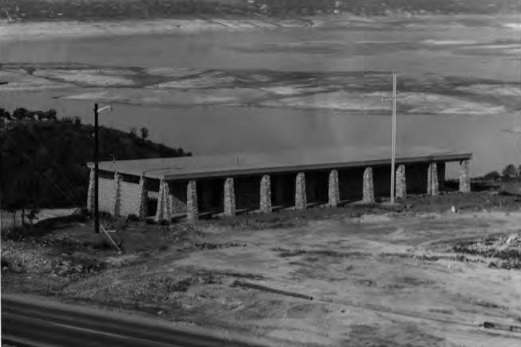
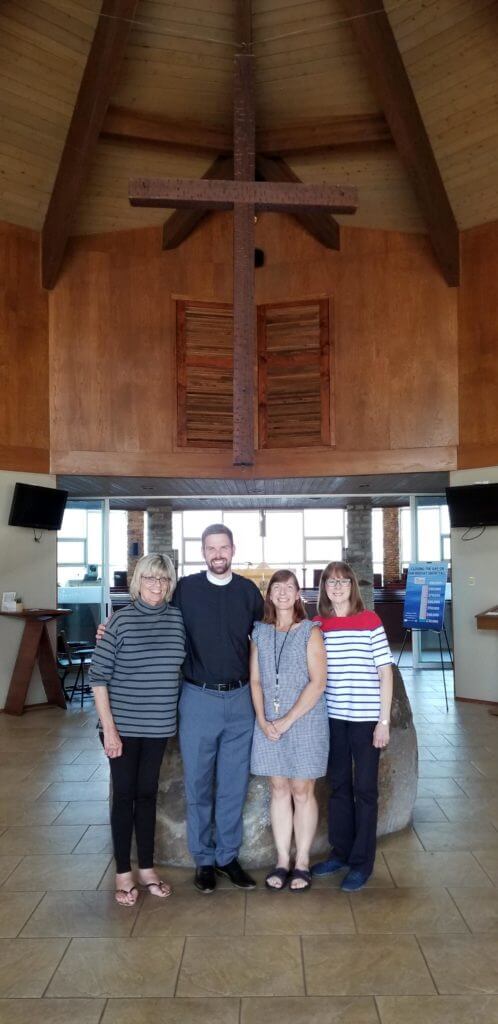
By SARAH DOOLITTLE, Four Points News
Founded in 1960, the iconic St. Luke’s on the Lake Episcopal Church, located on RM 620 on a hill overlooking Lake Travis, has long been central to the Four Points landscape and history.
It all started with local resident Louise Skidmore and the Reverend Malcom P. Riker, who at the time was the Reverend at Austin church St. George’s. Skidmore, who was a gifted stone mason and would later have a hand in building St. Luke’s, approached the Reverend about starting a mission in the Four Points area.
Rev. Riker was well known as a church founder, having “planted” eleven churches during the course of his career, eight of which were in Austin. Legend says that Riker responded to Skidmore’s request by challenging her to find five families willing to form a congregation.
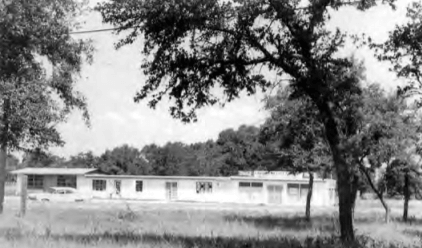
The Bait House
This Skidmore did and those five families had their first service in an abandoned Lake Travis bait house on December 4, 1960.
The bait house was a long, low building with no water or electrical lighting, its walls covered with bait tags. The group built their own altar and a communion rail that wobbled due to not being anchored to the floor.
At least they had music, from an organ that was, “attached to a vacuum cleaner. If you pumped, it made music,” according to founding congregant Frances Wray from the book “St. Luke’s on the Lake Episcopal Church: The First 50 Years.” Rev. Riker was moved nonetheless, as he noted in his diary at the time, by congregants, “determined to sing well to the tune of a roof leaking in a dozen places.”
While those early days in the bait house were vital to the church’s history, they were short-lived, as the bait house was sold and the group evicted after their first year. They were given 90 days notice.

The Parish Hall
In 1962, the Diocese of Texas purchased the plot of land on which the church stands today. Rev. Riker approached them about making the five-acre site St. Luke’s new home, but it took some persuasion on his part. According to founding member Anna Petty, “See, it was nothing out there at that time. Nothing. Just the view… (Rev. Riker) had to do an awful lot of talking to the Bishop because it was so far out there in the boondocks. The dirt road out there. And there were very few houses out there at that time.”

Rev. Riker worked his magic, though, securing a home for the new church with panoramic views of Lake Travis and the surrounding Hill Country. An early photo taken of the parish hall from above during construction shows Lake Travis full of large islands and its distant shores sparsely populated.
What was remarkable was that the original St. Luke’s Parish Hall was built almost entirely by church members and in time for the church to take occupancy before their 90 day eviction took effect.
St. Luke’s also had help from others in the community. As Petty described, “When we were building the first part of the church… neighbors of the other churches came to help us. They would bring food. We had lunches. It was a wonderful thing how the neighbors helped us out.”
The stone building’s masonry was completed in part by a local rock mason and in part by Skidmore and various helpers. Petty was one of those helpers, and fondly remembered how Skidmore, “did all the rock work in that first building, and she taught me how to clean rocks. I cleaned all those rocks!” (Skidmore built the original interior altars, which have since been replaced.)
Work on that first building was completed in just seven weeks at a cost of $5,000. St. Luke’s hosted its first Christmas service in December 1962. Petty remembered their first Easter service in April 1963. “They were out the door.” This new mission was growing fast and well on its way to becoming a parish.
The “New” Church
In 1965, the same architectural firm that had designed the parish hall designed what is known as a twelve-sided church to accommodate the expanding population of St. Luke’s.
“The symmetrical twelve-sided church symbolizes the 12 apostles and 12 tribes of Israel,” explained in the book “St. Luke’s on the Lake Episcopal Church: The First 50 Years.”
The building was made possible by multiple donations, including its donated 25-foot, white steel Celtic cross, which caps a central steeple.
In 1967, the congregation petitioned the Diocesan Council of the Episcopal Diocese of Texas to receive official parish status. Their efforts were successful, and at the council’s meeting in February of 1968, full parish-status was conferred on St. Luke’s.
1968 brought the construction of a new hall, named Riker Hall, which allowed the church to finally have, among other rooms, a full kitchen and dishwasher.
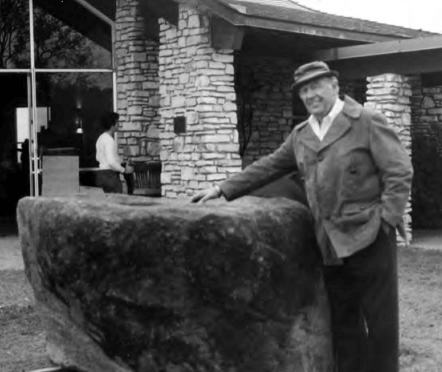
One stunning addition was made to the main worship hall in 1978 when members Colonel Ed and Mitzi Berry purchased a 15,400 pound rock from the beach at the Sea of Galilee in Israel and donated it to the church as a baptismal font. The 4,000-year-old stone, historically used as an olive press, was shipped first to Houston, then delivered to St. Luke’s via an 18-wheeler. Floor tiles had to be cut and laid to the stone’s edge, and it remains today in the spot where it was placed in 1978.
Women’s Group
From the beginning, congregants at St. Luke’s enjoyed a variety of social, spiritual and educational opportunities.
The Women of St. Luke’s was founded in 1963 and provided spiritual support and financial enrichment to the church. In the “The First 50 Years” book, Marian Miller described that the group“held annual bazaars, telephoned, taught church school classes, helped lead youth activities, typed, and provided music as well. The annual Christmas bazaars were so successful that in time The Women of St. Luke’s were able to donate $20,000 for the construction of a new kitchen in the Parish Hall.
The Women of St. Luke’s also staffed the church’s now-closed gift shop, which sold a variety of crosses, jewelry, decorative items and prayer books. Interestingly, the shop also sold James Avery jewelry, which at the time was sold exclusively through Episcopal churches.
Men’s Group
The men got involved in fundraising when the church began hosting an annual chicken barbeque in the summer of 1970. As Petty recalled, “They built a huge oven to do the chickens on… And they were always drinking a little beer.”
The chicken dinners became an established tradition that carried on for years. The Men of St. Luke’s was officially formed in 1990 and that group continued its long tradition of fundraising and maintaining the church through a variety of building and renovation projects.
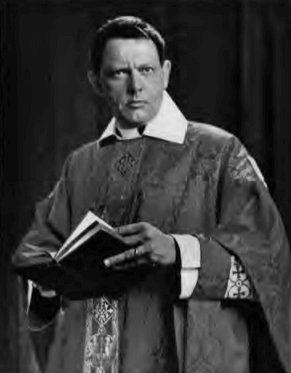
Library, Weddings, VBS
Thanks to a generous donation from founding member Catherine von Merz, St. Luke’s was able to establish and develop a small library in the 1960s. Von Merz donated her own collection of 2,000 books, and the library filled the void left by the absence of a municipal library in the area.
In addition to countless Bible studies, Sunday school classes and a choir, St. Luke’s provided for its congregants’ spiritual needs during celebrations. From the beginning, St. Luke’s stunning views provided the perfect backdrop for weddings, with Rev. Riker later writing that, “St. Luke’s is quite the favorite place for weddings, of which there are over 100 a year.”
Vacation Bible School was established for younger members of the church in 1977, thanks in part to a resistant new member of the church. Mary Duggan was frequently visited by Rev. Riker, who asked her why she had not yet attended St. Luke’s. She told him she’d attend when the church offered a VBS.
“In about a week my phone rang,” Duggan remembered. “And it was Malcolm Riker on the other end. With no preamble he said, ‘Sister Duggan, Vacation Bible School starts on Monday morning, and I expect you to be there and to teach!’ It did, and I taught.”
Steady Leadership
Perhaps most remarkable about St. Luke’s 60 year history is how few rectors have led it in that time.
Rev. Riker chose to leave the church and return to mission work in 1981 after more than 20 years as its spiritual leader. Having played a pivotal role in the church’s growth, Rev. Riker wished to refocus on one-on-one ministering.
“I want to go back into the mission field in order to exercise a more personal ministry to people through the extensive house calling and more intimate pastoral relationship,” Rev. Riker wrote in his three page letter of resignation.
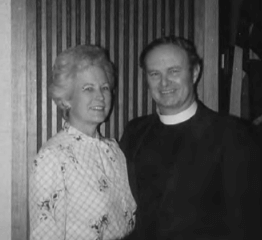
Rev. Timberlake
After a brief gap filled by an interim Reverend, St. Luke’s found its new leader in the Reverend Roland A. Timberlake, who started at the church in 1982.
Rev. Timberlake was a kind of two-fer, as his wife, Alice Jean, served as an active servant and leader within the church during their tenure.
The Texas natives were high school sweethearts and had three children together. St. Luke’s was only Rev. Timberlake’s third parish, having graduated from seminary of the Southwest in Austin after realizing a little later in life that something was missing.
“Being Rector of St. Luke’s on the Lake was the most rewarding and satisfying period of my life,” wrote Rev. Timberlake in “The First 50 Years.”
In his 20 years of service, Rev. Timberlake took on an almost fatherly role to those with whom he served. Mary Miner, who served then as today as parish secretary, recalled that Rev. Timberlake, “taught me a lot… Sometimes when he could overhear me talking badly about myself, he said, ‘Get in here.’”
“He said, I don’t ever want to hear you talk about yourself like that again. He was very encouraging, but when he put his foot down, he put it down.”
He could also be playful. Miner told how, “One time I was promoting a bake sale and somebody had made this wreath, so I put it on my head and went skipping down the aisle,” before a Sunday service.
Alice Jean shared memories of working in partnership with her husband to lead St. Luke’s.
“We both had ministries and we did it together. I was very supportive of him and he was very supportive me, although we had our different ways.”
Alice Jean led (and continues to lead) a number of Bible studies and is credited with having created two songs, “Come, Holy Spirit, Come” and “Good Morning, Lord.”
Rev. Timberlake’s tenure saw the beginning of explosive growth in the Four Points area. One example of this, as Alice Jean described, was of, “the highway increasing in size. We used to have an outside altar (where) we’d have outdoor services, but we had to do away with them ‘cause it got to be so noisy.”
That altar, also built by Louise Skidmore in a small courtyard, remains today but is no longer used for services.
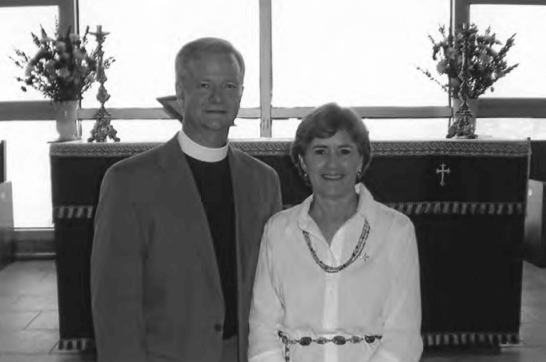
Rev. Wyckoff
Rev. Timberlake announced his retirement in 2002, and was succeeded by the Reverend Michael H. Wyckoff. Unlike his predecessor, though, Rev. Timberlake and St. Luke’s were not yet ready to part ways.
In 2007, he was invited by Rev. Wyckoff to serve in the role of Rector Emeritus. In this capacity he was able to act as a mentor to Wyckoff and a spiritual counselor to those he had served so faithfully for 20 years. Timberlake served happily in this role until 2015 when he died unexpectedly from a fall at home.
Rev. Wykoff served the church during turbulent times for the American Episcopalians. In 2003, the Episcopal Church elected an openly gay man to serve as Bishop of New Hampshire. This caused some conflict within the church as a whole as well as within local parishes. Rev. Wyckoff helped his parishioners to navigate this change in national policies and to bring fundraising back into line with previous goals in the succeeding years.
His leadership and talents were put to great use at St. Luke’s.
“I think everyone in our church agrees that (Rev. Wyckoff) is a gifted preacher and a wonderful teacher. He has a way of taking scripture and making even someone from Louisiana understand it. That would be me,” explained member Allen Griswold when writing humorously about Rev. Wyckoff in “The First 50 Years.”
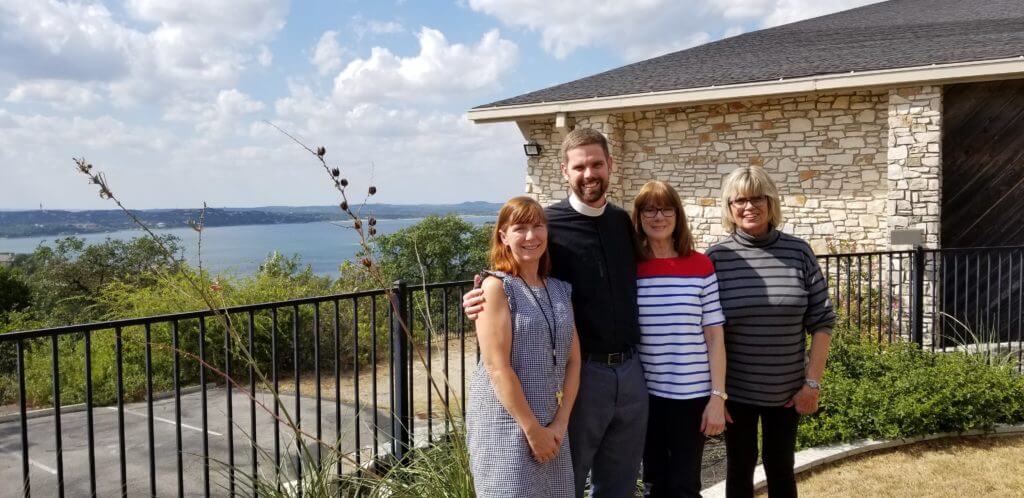
Rev. Yawn
As with all things, Rev. Wyckoff’s tenure did eventually come to an end when he chose to retire in February 2018. His successor, Rev. Justin Yawn, started at St. Luke’s in 2019, joined by his wife and one young son.
Rev. Yawn is young himself, as noted by current St. Luke’s Evangelism and Parish Life Leader Barbara Frazell. She said she never thought she’d be working for a man in his mid 30s. “We (staff members) could all be his mothers.”
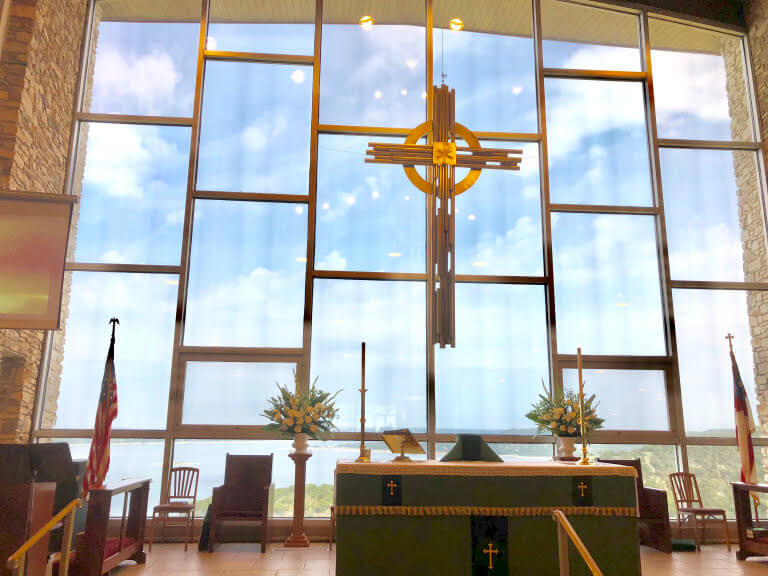
Next 60 Years
Sitting in his office overlooking Lake Travis, Rev. Yawn reflected on his parish’s history and his place in it.
“(Rev. Riker) is the missioner who came out to this frontier and brought a group of people together to plan a church. (Rev. Timberlake), you think about gardening… Roland watered the seed and nurtured the young plant as it came to life. (Rev. Wyckoff) came at a time… where there was controversy in the broader church, and he helped the tree survive the hurricane, holding it together as much as he could… Now I think we’re at a point where hopefully (we) will be more inventive and creative now that the storm’s past, we’re here… to continue to grow.”
Through all the changes, St. Luke’s has done just that: continued to grow in size, in population and in its mission to better serve its faith community as well as the Four Points community at large. St. Luke’s offers a variety of activities that are open to the public year round: vacation bible school in the summer, an annual carnival, a blessing of the animals every fall, as well as a number of fundraisers and holiday events.
And while St. Luke’s may have outgrown its parking lot, Rev. Yawn has kept his focus on the church’s true mission.
“I think we’ll grow up physically in our structure, but it’ll be born out of us growing up spiritually again and continuing on so we can continue to… get out into the world,” Yawn said.
St. Luke’s during COVID-19
In March 2020 when the pandemic forced shelter-in-place orders, St. Luke’s on the Lake Episcopal Church quickly pivoted. The first Sunday of the lockdown in mid-March marked the inaugural live-stream of our worship service. We quickly added an array of live and pre-recorded Bible studies, discussion forums, and education and activities for children and youth. In June, we served 75 children, some out-of-state, with our virtual Vacation Bible School. We are still refraining from in-person gatherings to do our part in stopping the spread of COVID-19; but we remain committed to serving the community and offering tangible support to people in need. This fall, St. Luke’s will begin a season of celebrating the 60th anniversary of our founding, and look forward to supporting Steiner Ranch and the Four Points area for many more decades to come.
